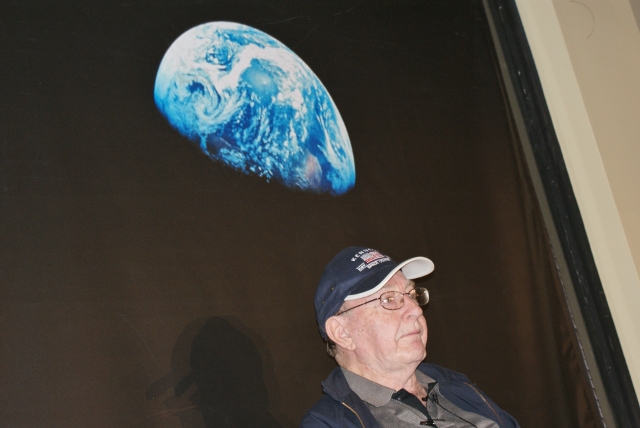
A contingent of Science Museum of Western Virginia employees waited patiently at the close of business last Thursday for a very special guest: Dr. Edgar Mitchell, one of only 12 men ever to walk on the moon.
Mitchell, who earned a doctorate from MIT, was a fighter pilot in the Korean War and was later chosen for the Apollo 14 mission in 1971. He piloted the lunar module (LEM) that he and the late Alan Shepherd took to the moon’s surface. “We were a good team,” said Mitchell of his relationship with Shepherd, who passed away about two decades ago.
Shepherd, the first American ever in space (a sub-orbital Mercury flight), famously hit a golf ball while on the moon. Mitchell boasted last week that the “javelin” he tossed on that same lunar adventure went farther than Shepherd’s golf ball. “He never really liked that very much but nevertheless he laughed about it,” recalled Mitchell.
At 82 he still lectures on a number of subjects and is concerned these days with the earth’s sustainability – which he says is threatened by overpopulation. The Science Museum and Virginia brought him to town for several weekend appearances and a museum fundraiser.
Apollo 14 landed in the Fra Mauro Highlands, where the ill-fated Apollo 13 mission that had to turn back was supposed to touch down. It was the first lunar mission devoted to scientific work; the first two landings (Apollo 11 and 12) were designed mainly to demonstrate that man could travel to the moon and back safely.
What does Mitchell think about the state of the NASA space program these days? “It leaves a lot to be desired.” On the other hand he is heartened to see that private industry is starting to flex its space wings, even offering commercial flights for non-astronauts. “Something like that is taking place at the moment.” Mitchell is friends with Bob Bigelow, one of the major players in the commercial space flight arena. “These are all opportunities for new discoveries.”
At the same time human beings need to be thinking about “how we get off this planet,” should the earth become uninhabitable. “Its civilization will have to survive. Which [also] means we have to get along better and find ways to get along without going to war and killing each other. That’s one of our problems.” Most of his thoughts now tend to dwell on sustainability and overpopulation on earth. The consumption of natural resources “at an alarming rate…our forests being wiped out,” are major concerns. “We’ve got to stop that.”
Science Museum Executive Director Jim Rollings has known Edgar Mitchell from his days at a museum in West Palm Beach. “It just seemed like the right thing to do, to bring him here to Roanoke. The chance to meet, talk and shake hands with any man who walked on the moon is extremely rare. They are national treasures.”
Sounding a bit like an echo from the ‘60’s, Mitchell said it was all about “loving nature and each other in ways … that we don’t know how to do on a global basis.” Even on his way back from the moon in Apollo 14, as he gazed at the big blue earth, Mitchell was pondering his world view. He had a mystical experience that he writes about in his book, The Way of the Explorer. The “big picture effect” he called it – thinking in global terms. The caused him to change the research he was doing – exploring what true consciousness means.
Mitchell said he had more education than many of the early astronauts, who were largely test pilots, and a wider set of interests. In fact his doctoral thesis at MIT involved plotting the trajectory for a trip to Mars. He retired from NASA in 1972 and set out to follow his passions. He also founded the Institute of Noetic Sciences. Mitchell understands why America stopped going to the moon; for one thing the general populace was saying, “ho hum, been there, done that.”
But we should go back to the moon added Mitchell, if we use it as a learning tool, helping to develop new propulsion systems that can take humans from earth if necessary. Mitchell said the concept that this planet has been visited in the past is becoming more widely accepted and he likes to ask the question: “How did they get here? If we’re going to go there we are going to need different technologies.”
By Gene Marrano
